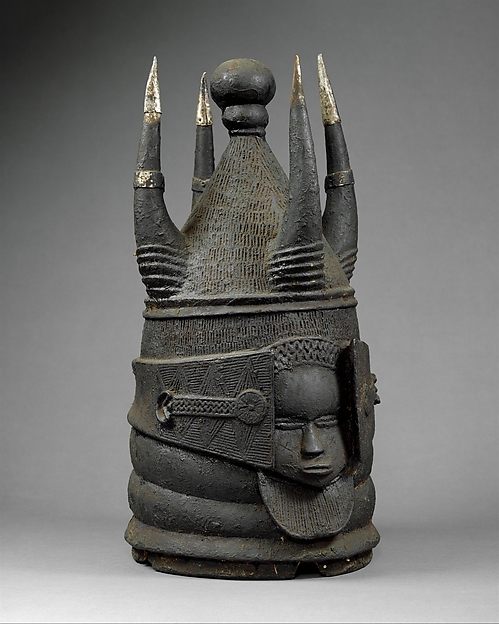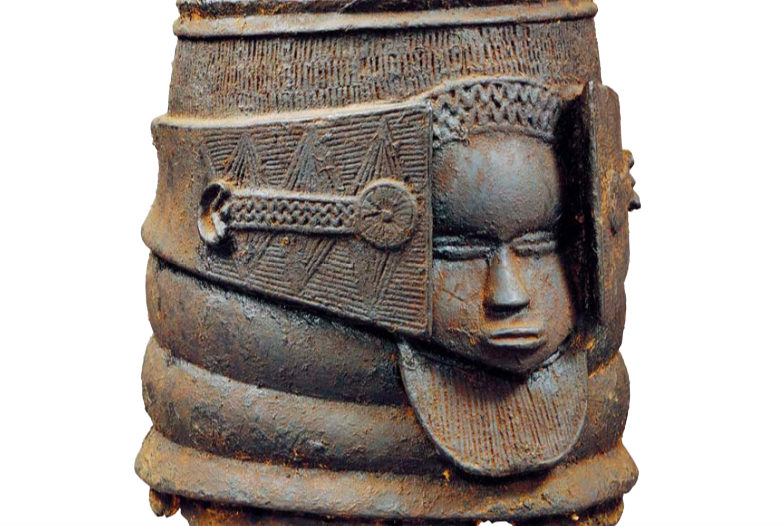The Mende initiation rite for young women is the only known masquerade tradition where the mask-wearers are female. Sowei refers most specifically to medicine—the kind of medicine that female healers/herbalists utilize. Embodied in this idea of medicine is a spiritual force. The mask, when danced, is a visual expression of this spirit. The term also refers to the custodian of the medicine—a Sande official. Helmet Mask for Sande Society (Ndoli Jowei), Mende peoples, Nguabu Master (Moyamba district, Sierra Leone), late 19th-early 20th century, wood and pigment, 39.4 x 23.5 x 26 cm (Brooklyn Museum, Brooklyn, New York)

Helmet Mask, 19th-20th century, Sierra Leone, Moyamba region, Mende or Sherbro peoples, wood, metal, 47.9 x 22.2 x 23.5cm (The Metropolitan Museum of Art)
This helmet mask reveals the hand of a master through its refined carving, harmonious design, and innovative elements. Within Mende and Sherbro culture, helmet masks are carved with symbolic features intended to endow the wearer with spiritual power. Senior members of two distinct initiation societies, Sande and Humui, may have worn this work in performances.
Sande is a powerful pan-ethnic women’s association responsible for the education and moral development of young girls. Helmet masks of this kind represent its guardian spirit and allude to an idealized female beauty. Historically, the Sande initiation process took months to complete, yet today sessions are coordinated with the calendars of secondary schools and may be completed during vacations and holidays. Such masks are worn by initiated Sande women at performances that celebrate the completion of the young initiates’ training period.

Detail, Helmet Mask, 19th-20th century, Sierra Leone, Moyamba region, Mende or Sherbro peoples, wood, metal, 47.9 x 22.2 x 23.5cm (The Metropolitan Museum of Art)
The masks are finely carved to convey admired feminine features: an elaborate coiffure, a smooth, broad forehead, narrowly slit eyes, a small, composed mouth, and a sensuously ringed neck. This composition of forms and symmetry creates a serene facial expression that implies self-control. The presence of a beard, a symbol synonymous with the wisdom men achieve with age and experience, may suggest that, through Sande, women attain knowledge equal to men. Directly below the curve of the beard are two slots through which the performer can see.
The mask’s glossy black patina evokes the beauty of clean, healthy, oiled skin. It may also refer to the blackness of the river bottom, where the Sande spirit is believed to reside. In this interpretation, the ringed neck may refer to the circular ripples of water that are formed as the Sande spirit emerges from her watery realm.
In Humui, a medicine society for men and women, this type of helmet mask has been used to address curative needs, especially mental illness. The four projecting animal-horn amulets that rise from the perimeter may be a reference to the animal horns filled with protective medicinal ingredients worn by Humui members.
© 2006 The Metropolitan Museum of Art, New York (by permission)
Additional resources:
About the Bundu (QCC Art Gallery)
Smarthistory images for teaching and learning:
[flickr_tags user_id=”82032880@N00″ tags=”Bundu,”]
[0:00] [music]
Dr. Steven Zucker: [0:04] We’re in the Brooklyn Museum, and we’re looking at one of several helmet masks for the Sande Society.
Dr. Peri Klemm: [0:10] This is a pan-West African phenomenon where several different ethnic groups participated in this masquerade tradition.
Zucker: [0:18] The mask we’re looking at would have been worn not in front of the face but on top of the head. The person who wore it would have been obscured by raffia that would have hung down over the face.
Klemm: [0:29] What makes it really unique is it’s the only masquerade tradition that we know of where women wore the mask.
Zucker: [0:35] Now, a man would have made this mask, would have actually carved it, but the entire ritual was performed by and for women.
Klemm: [0:41] It was made to help young girls go through initiation. Young girls among many different ethnic groups, including the Mende, whose group made this particular mask, would have been taken from their everyday lives and their chores to a secluded area in the forest where they would be instructed on how to become good wives and good mothers by the members of the Sande society.
[1:04] Again, this was a secret society that girls, all girls, were initiated into.
Zucker: [1:08] There’s real symbolism in being taken from the village into this more dangerous place.
Klemm: [1:13] This was a liminal time for girls. In fact, their bodies would be anointed with white clay to make them dry and pasty and unattractive, to suggest that they were not girls but hadn’t yet become women. It was outside of the realm of the village where this could take place.
Zucker: [1:29] If we look at the mask, it’s got a beautiful deep black sheen. The surface is smooth and glistening and is in such contrast to that chalky white.
Klemm: [1:38] This black shininess is the ideal. What the artist has done, the carver, is create an image that suggests an inner quality or the inner morality that young girls should strive for. The mask becomes an ideal for the young girls to mimic in their adult lives.
Zucker: [1:57] We see eyes that are largely closed and seem quite demure. We see a very small mouth and very petite ears.
Klemm: [2:05] These downcast eyes suggest that she should be reserved. The small mouth suggests she should keep her mouth closed and not gossip, gossip being the most dangerous thing in a small society in many cases. Then small ears so as not to listen to that gossip.
Zucker: [2:21] Probably most evident is this wildly elaborate hairstyle.
Klemm: [2:25] The hairstyle is where the artist has room for play. We have that seriousness of the face, this high, glossy forehead, but then we have this elaborate coiffure. We don’t know the symbolic meaning of all of these things. Many of this is learned as knowledge of that secret society.
Zucker: [2:42] This is not just historical, this a continuing tradition.
Klemm: [2:45] Because of the civil war in Sierra Leone and surrounding countries, all sorts of conflicts, we don’t know to what extent this tradition continues today.
Zucker: [2:54] One of the other most evident features are the rolls of fat under the chin.
Klemm: [2:59] The artist suggests that she is full-figured, that she has enough body fat to be able to bear children, and she is expected after initiation to marry and have children. This suggests an ideal again. Also, in seclusion during initiation is the only time a young girl is given really rich foods to eat and can enjoy time off. It’s intended to fatten her up a little bit, too.
[3:23] The Sowei mask is thought to be a spirit. She comes from the bottoms of rivers and lakes.
Zucker: [3:28] Below her eyes, there are four lines on either side.
Klemm: [3:32] These are scarification marks. They’re part of the ideal aesthetic for a young Mende woman. While the girls are in seclusion, in that liminal space, not yet women but no longer girls, they’re referred to as chrysalis, that is, not quite the butterfly but no longer the caterpillar.
[3:49] That shape is also echoed in the shape of her neck. We have a multiplicity of meanings, which are partly to do with the way scholars have studied them, but also to do with the fact that girls are exposed to different knowledge at different times in their life, when the Sande members feel that it’s appropriate.
[4:07] While this mask is intended to instruct young girls about proper womanhood, it actually never speaks, it never says a word, so this mask, silent, is able to teach young girls. The way in which that is done is through dance. The mask teaches the girls particular dance movements and stories through those dances, telling girls not only practical information on how to cook and raise kids but also spiritual knowledge and information about their belief system.
Zucker: [4:36] So the mask is this container of this very rich tradition. When we see it without its raffia, when we see it not worn, not part of this process of initiation, we’re seeing it really as an aestheticized object in the Western tradition, very different from the way this would be understood in its original context.
Klemm: [4:54] Young women think of this as a spirit when it’s danced with its raffia.
Zucker: [4:59] These masks would be used over and over again, but when they were not in the ritual itself, it would not have that spiritual presence.
Klemm: [5:05] It would have been housed in an elder woman’s home, who was an official from the Sande society. It was quite fine for young initiates to see it. They wouldn’t regard it as a spirit. They would regard it merely as a piece of wood because, again, it was not performing with its raffia costume and its attendants and musicians.
[5:24] [music]

